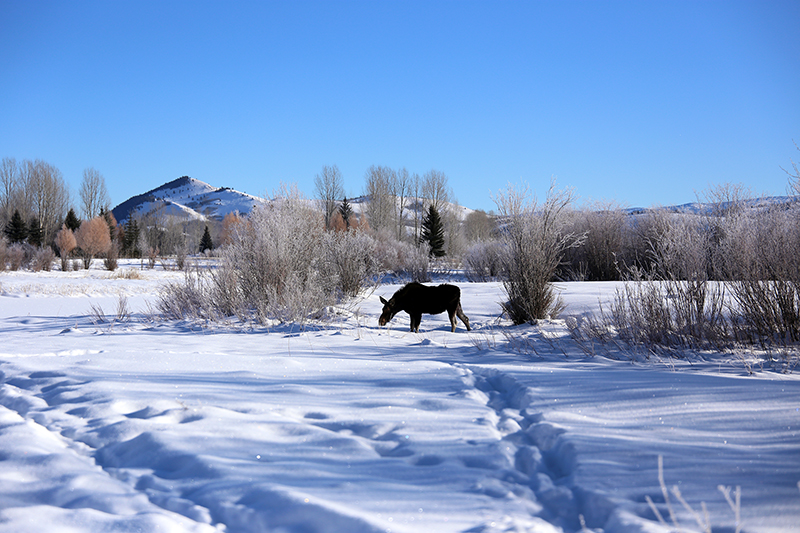The Wyoming Game and Fish Department team of biologists and veterinarians met at the Stilson Parking Lot at 8 a.m. Tuesday, when the thermometer on my car read just 2 degrees Fahrenheit. From there we drove into the River Hollow subdivision just south of Highway 22, but the first moose we found already had a collar on it.
“We had a little more luck last year finding them more quickly, so this year’s been a little slower,” said Aly Courtemanch, a wildlife biologist with the Game and Fish Department in Jackson. “I don’t why they’re just not as visible this week for some reason. Maybe they heard we were coming.”
Courtemanch said the team successfully collared one moose Monday, but they’re hoping to get a total of eight this week. Unfortunately on Tuesday morning, when I spent about four hours with the team, one moose located was too close to the highway. Another turned out to be a bull–and only cows can be collared for this project.
“During the breeding season, the neck on the male will swell up a lot,” Courtemanch explained, “and so it can actually be pretty tricky to collar males because you have to build in a lot of heavy-duty elastic into the collar so that it can expand and contract.”

The Game and Fish team located a cow moose (pictured) and her calf munching on the willows behind the Wilson Elementary School on Tuesday, Jan. 25. (Kyle S. Mackie/KHOL)
Finally, we got a promising lead: Two cows were supposedly hanging out in the willows behind the Wilson Elementary School. After a false alarm when I misidentified a dog, we located what turned out to be a mama cow and her calf.
Samantha Allen, the state’s wildlife veterinarian with Game and Fish, said she wanted to make sure the mom was full-grown before she got collared.
“I’d like to see her up, so I say we just bump her and see what she looks like,” Allen said.
A few members of the crew got close enough to encourage the cow to stand up, and she was indeed deemed big enough. Then Courtemanch started loading a dart that contains a mix of drugs that puts the cow to sleep in about 10 minutes once it’s hit so the biologists can take samples and fit it with the collar. That process only takes about 15 minutes and then a reversal drug wakes the moose back up.
Once ready, Courtemanch advanced slowly toward the mama cow and took aim with her air rifle but narrowly missed the animal’s rump from about 25 yards away.
“I think I might have missed her!” she said, laughing. “We might just load another dart to be ready.”
But Tuesday ended up not being the day for that particular moose. While the team was loading up a second dart, the pair wandered too close to a partially frozen creek, making it too risky to try and dart the mom again for fear that she might stumble onto the ice once tranquilized.
Courtemanch said Game and Fish estimates that there’s at least 70 moose living in the Wilson area. If you have a tip on where an uncollared female is located this week, you can submit it by calling the Jackson office of the department at (307) 733-2321.
To learn more about this project, check out KHOL’s coverage of last year’s round of moose collaring.






